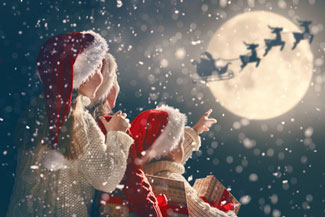Is it possible to locate Christmas spirit in the brain?
 Holly, turkey, chocolates, presents, reindeer, snow… Ah the magic of Christmas! But some people don’t enjoy this time of year and appear to be entirely lacking in "Christmas spirit." Until now, the phenomenon had escaped the scientific radar. But Danish researchers decided to conduct a (both serious and facetious) study to detect the "Magic of Christmas" in the human brain. What happens in the brains of Christmas addicts?
Holly, turkey, chocolates, presents, reindeer, snow… Ah the magic of Christmas! But some people don’t enjoy this time of year and appear to be entirely lacking in "Christmas spirit." Until now, the phenomenon had escaped the scientific radar. But Danish researchers decided to conduct a (both serious and facetious) study to detect the "Magic of Christmas" in the human brain. What happens in the brains of Christmas addicts?In order to locate “Christmas spirit" in the brain, researchers from the Departments of Neurology and Clinical Physiology, and Nuclear Medicine (University of Copenhagen, Denmark) compared a group of 10 people (8 men and 2 women) that had been celebrating Christmas since their childhood to another group composed of 10 people (identical composition) that had no Christmas tradition. The participants in the "Christmas group" were all Danish and those in the "non-Christmas group" lived in the same area of Denmark and were either Pakistani, Indian, Iraqi or Turkish.
The subjects in each group underwent an MRI scan while viewing a continuous series of 84 images in sequences of 6: 6 Christmas images (considered as a "stimulation block") followed by 6 images of everyday life (the "rest block"). Each photo was shown for 2 seconds. Following the viewing phase, each participant answered a questionnaire about their Christmas traditions and their feelings about the holiday.
The brain activity of the “Christmas group” was compared to that of the “non-Christmas" group. What happens in the brain when we look at pictures that evoke Christmas? The scientists identified 5 areas of the brain that were activated in the participants who love Christmas. These are the somatosensory cortex (involved in recognizing facial emotions), the primary motor cortex, the premotor cortex and the inferior and superior parietal lobules (that may play a role in self-transcendence and spirituality). According to the authors, there is a “spiritual Christmas network” in the human brain that is composed of several cortical areas which are significantly more active in people who like celebrating Christmas than in those who don't recognize the tradition.
The researchers are however aware of the limitations of the study: there is no way to tell whether the activation they observed isn’t simply due to a combination of general joyful, festive, or nostalgic emotions and not specifically linked to Christmas. In addition to the cultural differences with regards to Christmas, the groups may also differ in other ways. But as the authors of the study (which appeared in the very prestigious British Medical Journal) mischievously emphasized: dwelling on the limitations of the study “really dampened the festive mood. Therefore we, in the best interest of the readers of course, decided not to ruin the good Christmas cheer for everyone by letting this influence our interpretation of the study.”
So whether or not the “spirit network” really exists, Merry Christmas!
Source: A. Houhaard, U. Lindberg, N. Arngrim, H.B Larsson, J. Olesen, F. M. Amin, M. Ashina, B. T. Haddock, “Evidence of a Christmas spirit network in the brain: functional MRI study”, in BMJ 351, Dec. 2015







